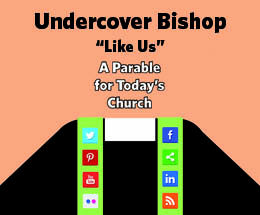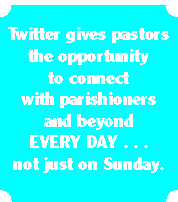Chapter 2
Bruce James Meets the Bishop
 Bishop Kinisa was listening to Bruce James as he talked with exuberance about the potential for Social Media in ministry.
Bishop Kinisa was listening to Bruce James as he talked with exuberance about the potential for Social Media in ministry.
She was conscious that listening to the young, recent seminary graduate was work. Her mind was hearing his words, but other thoughts—defensive thoughts—kept creeping in.
Social Media was a mystery to her. There was just one thing she hated about being bishop—reading email. In fact, she had delegated her email to her secretary. Pam saved her hours a week by prioritizing her messages. She managed to whittle 150 morning messages down to just a dozen or so. Ruby was proud of her office’s efficiency. Less time online meant more time in mission.
She recalled how Gil had insisted their Communications Director sign her up for Facebook. She had agreed reluctantly. Now months later, her Facebook page just sat there. “If it’s so great, why don’t I ever feel the urge to look at my own page?” she wondered.
But there was another nagging thought that was muting the words of the seminarian. She knew him better than the other members of his seminary class who were knocking on her door, looking for calls. She had grown to like him and felt friendly towards him. But this is the first time a seminarian had come to her with anything but hat in hand. Much as she liked Bruce she couldn’t help but marvel at his nerve. Was this the same Bruce James she had worked with just a few months ago?
Gil noticed her lapse in attention.
He pressed Bruce to skip over his theories. “Bruce, it sounds like you have something concrete in mind. How do you see this working?”
For the first time, Bruce stammered in his presentation.
“I feel a bit awkward,” he confessed. “I am usually not this forward. It’s just that this idea is so real to me—so promising. I know it must sound crazy to you but I just feel compelled to pursue it.”
He paused to read Ruby’s and Gil’s reactions. He saw encouragement in Gil’s face, but wasn’t sure he was reaching the bishop.
He decided to try another direction.
“Bishop Kinisa, we traveled together to three churches earlier this year. I worked with you for several months after you revealed that you were their bishop. I felt very lucky to be part of that experiment. I learned more visiting the three “Undercover Congregations” than I did in my field experience these last few months—maybe even in my three years of classes!”
Ruby felt the need to gain some control in the conversation. She resorted to her usual interview techniques with first-call pastors.
“Where did you spend your field experience, Bruce?”
Bruce answered quickly. He wanted to be polite and respectful, but he also wanted to get his message across.
“I served with Pastor Rolf Anders at First Lutheran.”
Ruby knew both Pastor Anders and the large suburban congregation well.
“How did you like being in a large congregation after spending so much time with Pleasantville, Grace, and Zion?” she asked.
Bruce answered. “I expected it to feel different, but the longer I was there, the more that I saw that First has many of the same challenges as the much smaller “Undercover Congregations.”
Gil, at last, jumped into the conversation with both feet. “Tell us about that, Bruce.”
“Well,” Bruce ventured with some hesitation, “there are just two major differences, really. One, there are more people—obviously. Two, they had a long-term relationship with Pastor Anders. These two factors defined their ministry.”
“And how did this make a difference?” Gil prodded.
“It’s really hard to explain,” Bruce answered. “When we were working with the Undercover Congregations, the people were always in—I’ll call it ‘problem-solving mode.’ You know what I mean, don’t you? The people were always presenting ideas, looking for new possibilities, constantly reinventing themselves. The people of Trinity seemed more content in the ministry they had built over the years with Pastor Anders. Their approach to ministry was more about doing the same things better.”
Now Gil was taking charge. “So which experiences shaped your passion for Social Media ministry, Bruce?”
“That’s the easiest question you’ve asked me so far!” Bruce commented. “The answer is BOTH!”



